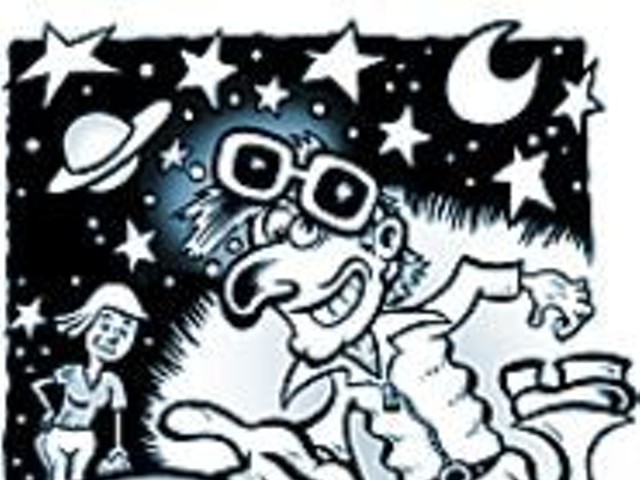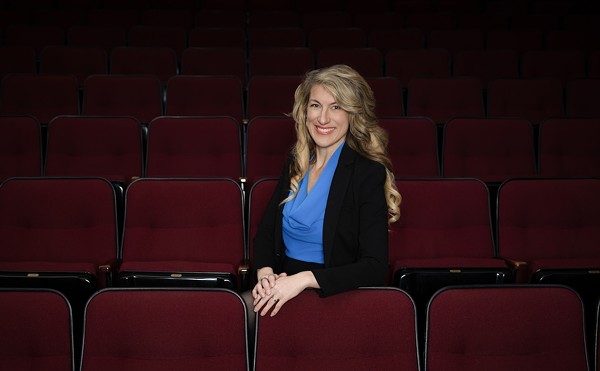Beckett figures he's been in shoes for 20 years, first working retail at Macy's as a teenager in Atlanta, then getting involved in product development and, eventually, becoming a designer for Brown and Wohl when he moved to St. Louis about 10 years ago. He arrived in St. Louis to take up the shoe trade long after the downtown shoe factories, which once were as central to the city's identity as beer, had been abandoned.
"The thing that interested me was that I enjoyed fashion," Beckett says of his pre-designer days. "I enjoyed seeing someone who put clothes together nicely. Fashion is like art to me."
Now working out of his home, he designs for the Ann Marino line of the firm New York Transit, which has corporate offices in San Francisco and New York. "Living in St. Louis is not an obstacle" to being an international shoe designer, Beckett contends. "It's important to travel and have a whole scope of ideas," he says, and St. Louis is an easy place from which to travel. More important to his success than frequent-flyer miles, however, are all those years spent on the Macy's sales floor, discovering what women want: "What's been interesting about my career is, I both design and have a touch for retail. I have a feel for what can sell. Some people come up with designs, but they don't apply to the consumer."
What women want, according to Beckett, are shoes that are fun, contemporary, feminine and, sometimes, sexy. From his Barney's bag he starts producing shoes and setting them on the table. "We're known for beautiful evening shoes," he says, showing off an elegant black dress shoe with a frill of beads. A bright dress shoe with straps comes out of the bag, the straps garnished with small mirrors. For spring 2001, Beckett says, "Coloration is very fun and very vibrant," and he holds up a shiny violet sandal as cool and inviting as a Popsicle. Summery footwear is pulled from the bag -- it's like the seasons changing at the lunch table by way of soles and linings and heels, unaccompanied by Vivaldi. "We're making use of psychedelic fabric, of floral sock lining, and shine is important," Beckett notes. Just when the conversation turns to retro fashion and thoughts of Bardot in something like that little red gingham sandal come to mind, the server arrives and all the shoes must be moved out of the way for the grouper.
The feet don't lead in fashion, Beckett explains when the plates are cleared and the conversation turns back to shoes. The shoe designer doesn't take the couture lead but follows, adapting to the trends in ready-to-wear. Shoes need to go with the clothes, not the other way around. Beckett doesn't appear aggrieved in the slightest by this. He has nothing of the frustrated high-fashion designer about him -- leave attitude to the fashion dictators. Beckett is not one to impose a style on women. He keeps watch on European trends, but he understands there are some things American women just won't do: "In Europe, there's a tremendous amount of pointed toes and high stiletto shoes. Very few American women will go through that pain. We adapt European design to relate to the American market."
This doesn't mean that American style is a mimicry of the European -- far from it. "Europe used to be considered ahead of us," he says, but fashion has grown into more of an interchange. Go to Europe or Asia, he notes, and you'll see that American style is predominant. If the term "global village" has any relevance anywhere, it's in the world of fashion. Beckett keeps his eye on what the lady in Dubuque or Chesterfield might wear relative to what the lady in Milan or Florence does wear.
There's a certain amount of clairvoyance, a reading of signs, involved in his creative process. Beckett refers vaguely to fashion-research services that are available and more mystically describes his own "touch and feel." He's completing a line for fall 2001 to be debuted in a major runway show in Las Vegas this month; at the same time, he's "starting to put colors to bed for spring 2002." With a professional demand for foresight, it's not surprising that, when asked about his early designs, he says he can't remember: "The cycle of fashion changes. Whatever was in at that period of time was what I was doing."
"Cycle" implies "return," and fashion is always coming back around to those styles the designers thought they had forgotten. Beckett believes it's the constant appearance of the new old thing on the horizon that helps him avoid designer burnout -- he's always excited by what is becoming new again. "You're going to hear that for fall they're going to revisit the '40s," he says. Ready-to-wear "is touting the return of the suit for women," with an influence of men's styles: tweed, plaid, houndstooth. The advertising tagline will refer to The Portrait of a Lady, Beckett says, although the Jamesian allusions are sure to be left far from the runways and will never get anywhere near the malls. But, then, who would want a Jamesian allusion in their shoes, anyway?
Beckett prefers to keep his designs whimsical, which is proving successful for both him and his company. One of his designs for this spring "just flew out" to retailers, he says: an open-toed slide made of lenticular vinyl, the material serving as a canvas for 3D images. A flower turns into a butterfly, into a flower, into a butterfly as a woman walks; a school of fish transforms into a coral reef. The idea, says Beckett, came from kids' 3-D stickers, not the ones in which the image of Christ becomes the shroud of Turin -- but who knows what could happen next in the world of fashion?
Fashion can be criticized as a superficial art form, but what ends up on women's feet can have as much social significance as what Elliot Smith hangs on his gallery's walls. If European women are willing to grimace through an evening in those pointy toes and stiletto heels whereas American women would rather walk blithely down the boulevard going "tulip, butterfly, tulip, butterfly," there's enough to be derived from that cultural contrast for at least one epic dissertation in a variety of fields.
But don't expect any sort of academic exploration into the cultural meaning of fashion from Beckett. Another season, another show: "Women used to dress up for work and change into something casual when they got home. Now they're dressing casual to work and want to dress up when they go out." This year, it's an embrace of the feminine; in another year it will be something else -- no-nonsense footwear or she-wolf footwear.
Beckett flies to Milan, flies to London, flies to New York, flies to San Francisco and returns home to Chesterfield and tries to read the trends: "For this winter, boots were dominant in fashion, and we see that continuing." He goes to his sketchpad and thinks about that Portrait of a Lady theme and what shoes will go with that. He thinks about what's coming out in handbags and jewelry. His original sketches, he says, then "need to be focused down to what really is going to be put into a live prototype. Then that needs to be refined." Already he predicts the "purple family and green family" will be prominent colors for 2002. When preparing a line for the runway, he also must pick the clothes and accessories to best accentuate the shoes. "It's fun, not stressful," he says of the runway extravaganza.
And does he really like these creations? Is there any hint of cynicism involving the business of decorating a woman's foot?
"I love 'em," he says happily.





